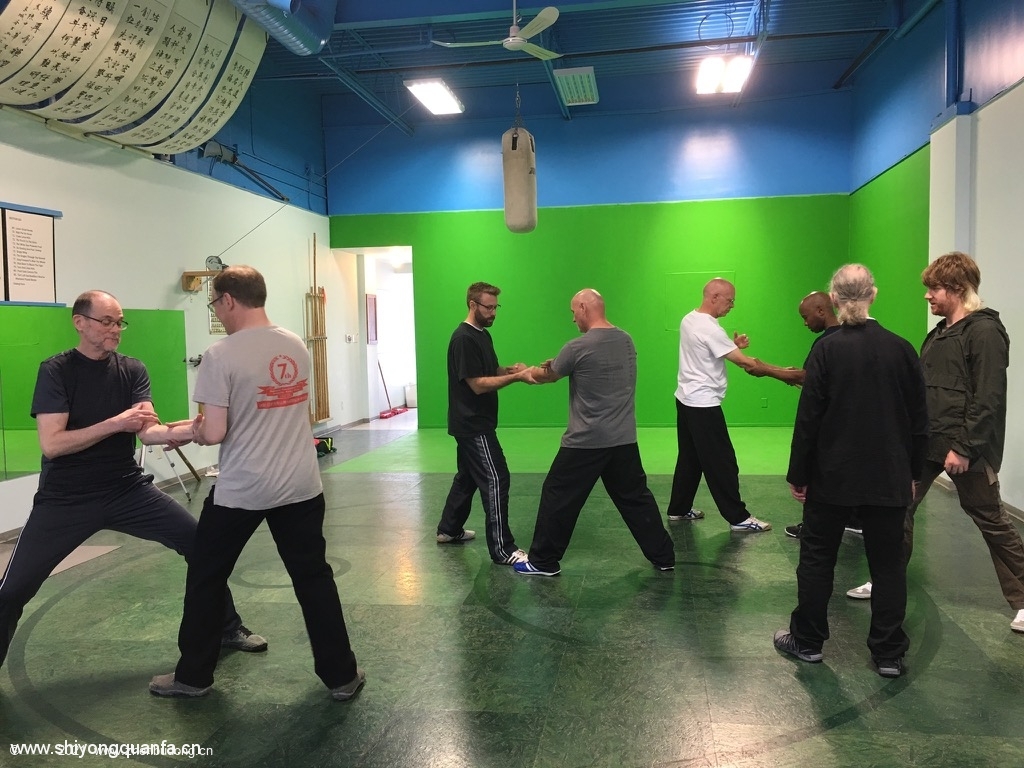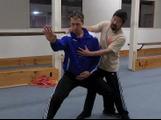Notes from Grandmaster Zhonghua Chen Workshop on Sept. 14 & 15, 2019, Edmonton, PM Studio

埃德蒙顿2019.09.14讲座合影。本文作者是右四(后)。
• worked on positive circles with much more specificity of movement: just move elbow to rib/shoulder/kua crease, open/rotate bi-cep clockwise with elbow on crease, keep elbow on crease while opening/rotating front kua, switch awareness/intention to rear kua, create wall with front arm, keep fingers engaged, move edge of palm outwards pulling rest of arm with it, with no movement of the elbow (one of my many difficult areas) until necessary, gradually raise elbow upwards as palm pulls arm out, use rear kua stretch to help palm pull out the arm, oh yea, don’t move anything else…
• create separation between body parts, then re-combine
• don’t try to move body parts in contact with training partner, leave them immobile, inert, stick like while moving rest of body around those parts
 • isolate/extend/rotate
• isolate/extend/rotate
• create definite separation between internal/external body parts & move them independently of each other
• body sections in touch with training partner must be uncommunicative of your intentions; keep them engaged but basically inert while you move elsewhere
• if you move, only do so through the positional changes brought about by footwork
• separation is connection
• when you initially come in contact with a training partner, create a Yin/Yang split immediately in at least one place (more is better but not very likely for this beginner)
• Leads or heads are the areas that are active/moving while rest of body appears not to move externally (much going on internally);
1. first level are the natural leads (hands, feet, head)
2. second level are the less obvious movers, elbows or kua’s
3. third level is where every body part can be created via intention & proper structure to be prime movers (very advanced)
• arms must move through a straight line
• must work on desynchronized synchronization (also a challenge pour moi)
• different joints rotate at different speeds, pay attention to this, study this, ask questions about this
• almost always move feet in a way that is desynchronized with any arm movement
• only one body part should move at a time
• advance while retreating is not notional, represents what the body actually does mechanically
• work towards powering up without tensing up
• work on only powering up a single body part (lead) at a time (note double heavy concept)
• to power up any lead against a muscularly powerful partner have to sink & brace the line onto back foot
• power up upper body leads by folding/isolating/elongating that body part onto same line as back foot
• any line from back foot can be combined & re-aligned with other joints/tendon stretches to change the direction of the line
• tuck/fold upper body parts into the shoulder/rib/kua groove
• untrained &/or externally trained people mostly move unidirectionally, with everything moving in that one direction/PM seeks to create movement that is multi-directional, segmented & moves in a desynced/synchro way
• allow training partner to have whatever inert body parts they touch, then create leads in a ripple pattern at point of contact
• several hours on finding, creating, capitalizing on the point of demarcation that is available in any two moving parts in contact with each other; that point at which movement is effortlessly possible
• avoid conflict, do not fight, render the point of contact inert, find ways to move around the fight
• correct technique is inhuman power (advanced skill)
• one can compare learning PM Taiji to learning a language, must try to be able to speak the new language in a way that is as close to ‘native’ as possible as if it were one’s ‘mother tongue’, without developing deep understanding one can only copy superficial elements of PM Taiji
• watch & listen to your teacher always, not just in class demo’s, see them interacting with the world & begin by mimicking those movements, ask to touch the teacher, ask the teacher to show you the internal elements & to move those leads as you touch them, absorb as much of what & how the teacher does what he/she does and you will move towards ‘transmission’ of the art
• no change in what teacher tells me, no insights, no modifications, replication only until it becomes part of me, then I can make it an art and my own
• remember the actual words and movements, nothing else will advance our skills
• adjust/adjust/adjust; change leads
• find/examine/create points of demarcation, they are gold
• PM is the simplest of all martial arts; there is only Yin/Yang separation
• this work, this practice changes the body, we are reborn, that is true training….


